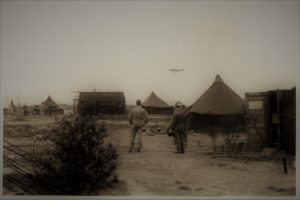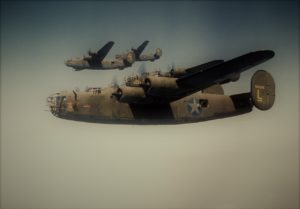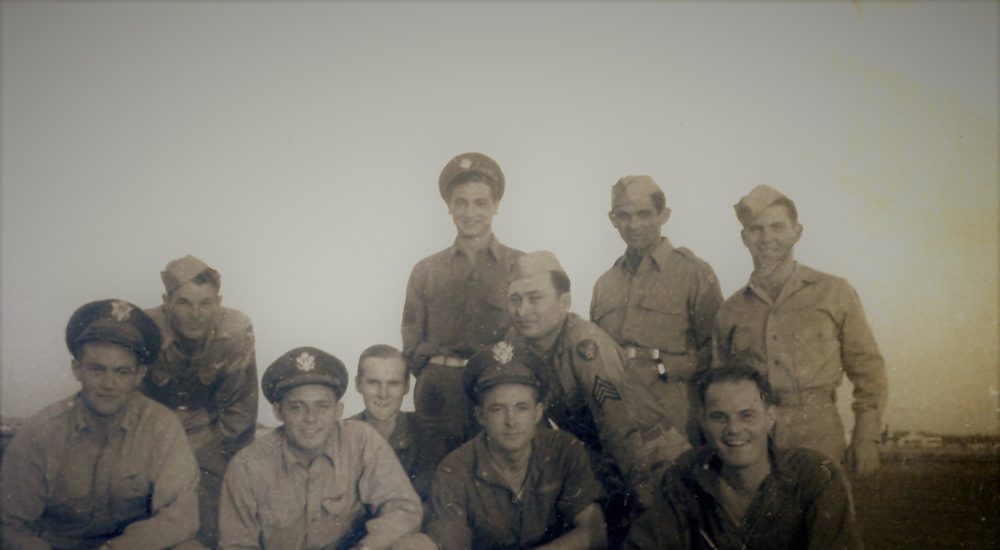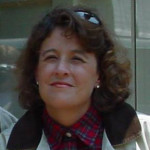Wings Above Fear, Chapter 1
This story is dedicated to the people of Italy, and to my friend Claudio Ghiotto of the village of Vo and his beautiful family. In a day and time when the sacrifices of our service men and women sometimes seem forgotten, I am profoundly humbled that you remember….
In a day where here in the United States, we argue about whether or not to stand for our flag or the national anthem … thousands of miles away in Italy, you remember….
In a day where over half of millennials cannot answer a single question about World War II, the people of Italy remember our American soldiers with commemoration, honor, and friendship.
If I could ask just one more favor from you, lovely country, it would be your secret to teaching the next generation the real price of freedom.
Chapter One: Seventy-five years ago this week….
The early morning of December the 28th in 1943 was overcast at the American air base at San Pancrazio. Located in the boot region of southern Italy, this area was firmly controlled by friendly forces. Only a few months earlier, after the successful invasion of Italy by the Allies, the airfield had been constructed by United States Army Engineers and was home to the 15th Air Force.

Recently transferred from the 9th Air Force and assigned to the 15th in late September of 1943, the 376th Bombardment Group had already made their mark in significant engagements including Operation Tidal Wave, the bombing of the Ploesti oil fields in Romania.
The 376th was a special group originally created to harass the Japanese as a “second wave” to follow Jimmy Doolittle’s Pearl Harbor “Revenge Bombing,” flown off the carriers in the Pacific. The airfields they planned to use for these new missions were in China, but soon fell to the Japanese. The group was then redeployed to airstrips in and around North Africa. Here, they had been giving Rommel’s Afrika Corps a hard time by interrupting his supply line in all directions.
Calling themselves the Liberandos, they were so successful at mobility and scrambling the heavy bombers quickly into the air that they were then incorporated into a plan to support the Soviet Union in the Transcaucas. When Russia made it plain they only wanted the aircraft and not the pilots and crews, the deal fell apart.
Before Rommel’s departure from Africa, they continued to fly from bases in Palestine, Egypt, Libya, and Tunisia. There were four tactical squadrons which comprised the 376th’s Bomber Wing and they were the 512th, 513th, 514th, and the 515th. The 376th also attacked shipping in the Med and bombed Axis supply lines like airfields and harbor installations in Libya, Tunisia, Sicily, and Italy. By December of 1943, their home base had been established at San Pancrazio, and they had already won two Distinguished Unit Citations. They were the first B-24 bomber group to be based on, and bomb, the European Continent.
Causalities had been heavy with the bombing of the oil refineries in Romania in 1942 and again in ’43, and a large group had begun to arrive from the states in late August of that year to replace pilots and crew. They were flying the new bird called the B-24 Liberator all the way from the states with a stopover in Labrador, Scotland, and then the Middle East.
The casualty reports were a mixed bag depending on how you looked at it, but the word was out that some of the blame should be placed on the newly and hastily designed aircraft the men were flying. These new B-24s were on their way to replacing the B-17s, and they were certainly a bird of a different feather. Aficionados of both would still be arguing 75 years later about which was the better plane.

The good news was the B-24s could go twice as far and carry twice the bomb load of their predecessors, but the bad news was they were difficult to fly, especially in formation, had issues at high altitudes, and a history of on-board flight fires.
Other issues included unforgiving rigid trim flaps, which added to the pilot’s need to nurse the flight the entire time. Many complained of left hand and arm fatigue due to certain controls placed there. One crew member during the war was heard to say, “The only reason a Liberator ever got airborne was the curvature of the earth.”
Made by “Consolidated” beginning in 1939 to answer the call for a larger bomber and unlike the B-17 with its broad deep wings, they featured high-mounted, long, narrow wings which were not the usual “V” shape to inhibit rolling. The completely straight high placement of the wings enhanced the air speed, but there were other drawbacks. The design of the fuel tanks which at first were not self-sealing included not only the wings but part of the fuselage. This created greater numbers of on-board fires when the B-24s took flak.
In addition, the thin wings had a tendency to give way if shot up, while the heavier wings of the B-17 kept even badly damaged aircraft in the air. All of these issues taken together were said to make the B-24 more vulnerable to battle damage and less likely to stay aloft, allowing the crew to escape.
Even so, with faster speed and a large fuel capacity, they were being called on to fly long-range missions, not only over Axis countries, but to deal with the enemy submarine problem thousands of miles out at sea.
Here in San Pancrazio, these Heavy Bomber squadrons were now focused on the strategic bombing of Europe. These included weapons factories, marshalling yards, bridges, and oil refineries in Germany, Italy, France, Czechoslovakia, Austria, Hungary, and the Balkans.
Just a few days earlier during that December in 1943, a bomb run on Christmas Day to the rail yards in Vicenza in Northern Italy had proved uneventful, with specific targets successfully reached and destroyed. There was a back and forth, however, between the CO and the squadron leaders the morning of the 28th in the briefing room about the very same assignment. This had more to do though with the murky, cloudy weather and poor visibility than any worry about casualties.
The decision was tentatively made to climb through an opening in the clouds just above the base and assemble the formation at an altitude of 1000 plus feet, an action which involved a total of 18 planes and which would somewhat delay the mission, even if the green light was given. They were then to proceed 500 miles north to Vicenza to the strike site where the rail yards were located. At the 300-mile point they were instructed to rendezvous with the 98th Heavy Bomber Group and a unit of P-38 Lighting fighter planes from the 82nd as an escort to provide cover.
The crews were told to stand by on the ground with their plane and wait for either a green flare to go, or a red flare for mission canceled. Gathered around their B-24 Liberator was the six-man enlisted crew of Ole Sarge, serial number B-24D-85-40658.
An older model B-24D, she had three .50 caliber guns in the multi-paneled Plexiglas nose of the plane but they did not rotate in a turret like the newer versions. This D model also had a upper “Martin Turret” just behind the cockpit, and a tail turret, each with .50 caliber guns.
Older models, and some planes that had been repaired, were minus a retractable belly turret. Instead, they were fitted with what was called a “Tunnel Gun” which was essentially a square frame mounted into the floor of the plane just behind the bomb bay with small windows and a .50 caliber gun in the center. On either side between the wings and the tail were two openings where left and right “waist gunners” with machine guns could operate, bringing the total number Ole Sarge carried to ten.
Most of the planes were known by nicknames given affectionately by the crew. Many also had the number of missions painted on one side represented by pictures of bombs. Ole Sarge had known several sets of crews previously, as it was a veteran of many campaigns, including the infamous oil field raids in 1943.
With a bulldog’s head in uniform and the name “Ole Sarge” painted on her nose below the cockpit, she was one of the least decorated and painted planes in the theater. In contrast, across the tarmac that morning from Sarge was “Red Wing” of the 514th. Red Wing had not only her name painted on the side, but a beautiful and extremely scantily clad Indian maiden above her name.

Arriving on the runway after the briefing, as the sun began to come up over the horizon, were the four officers assigned to Ole Sarge: Pilot Lt. Thomas Haigh; Co-pilot 2nd Lt. Walter Matthai; Navigator 2nd Lt. Norm Troxell, and Bombardier Lt. Ward Walker.
The four men, as well as their six-man enlisted crew had been together for 14 missions since October 15. They shared as their HQ a large farm building left at the airfield when it was commandeered for a base of operations. The enlisted men were billeted nearby in tent rows with a mess hall attached to the row at the end while the officers had a common bunk room in the building upstairs. The officers club and mess hall were located downstairs on the first floor.
To catch a glimpse of what America was in the mid-1940s, one would only have to take a snap shot of the crew that morning preparing to fly Ole Sarge. They were all fresh-faced boys with an average age of 25. The advent of what had already proved to be a terrible and bloody war had ironically provided avenues of education and opportunity for many men who might otherwise have been joining their fathers, farming, working in factories or clerking in banks.
Next is Chapter Two: The Crew Members of Ole Sarge.
Cover photo: The crew of Ole Sarge: (kneeling in front row) Bombardier Lt. Ward Walker; Pilot Lt. Thomas Haigh; Co-pilot 2nd Lt. Albert D. Matthai; Navigator 2nd Lt. Norman Troxell (tentatively identified).
(Back row) Gunner Sgt. Leonard Hager; Engineer Sgt. Peter Stiles (kneeling), Tail gunner, Sgt Joseph Kerschner (tentatively identified); Gunner Pvt. Winston Ivey; Armorer Gunner Sgt. Romero Giagnoni; Radio Operator Sgt William Butler.


